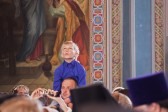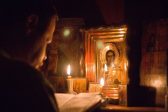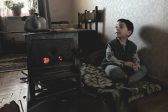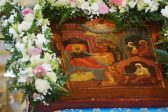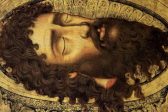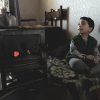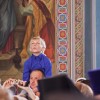The Pontian genocide of
1916-1922 is the most tragic page of Pontian Greek history. The Pontians
had suffered a lot throughout their history of nearly 3.000 years, but
the genocide was the most terrible of their misfortunes, for it deprived
the Greeks of the Black sea not only of their friends and relatives,
but also of their native land. And it is evident that remembrance of the
genocide is necessary not only for relatives and descendants of the
lost – such terrible facts of human history must be known to all. For if
people forget about the pain of other people, if they pass it by with
indifference, they kill inside their souls a part of their “humanity” –
and this must not be allowed to happen, lest tragedies of this kind
might be repeated…

1. Pontian Greeks – who are they?
1.1. A brief historical overview
Euxinos Pontus (Εύξεινος
Πόντος) or just Pontus (Πόντος) – this is how the Greeks used to call
the Black sea from times immemorial. The first Greek settlements
appeared on its southern coast (modern Turkey and the Caucasus) as early
as 800 BC. They were founded by Ionian Greeks, natives of Attica,
Anatolia, and the islands of the Aegean. The first city, Sinop, was
built in 785 BC Very soon not only the southern, but also the northern
Black sea coast was completely Hellenized. Many renowned Greek men of
antiquity, such as Diogenes and Strabo, were born and raised in southern
Pontus.

In the 4th century BC, an
independent Kingdom of Pontus was established on the southern coast of
the Black sea, headed in 301 BC by king Mithridates I. Since that time,
Pontus began to develop independently from other Greek lands.
The dynasty founded by Mithridates successfully ruled in Pontus
until the 1st century BC The Kingdom of Pontus prospered,
science and arts flourished in its cities. The last king of the dynasty
was Mithridates VI Eupator, who ruled from 120 to 63 BC. He resisted the
Roman expansion much longer than other Greek rulers, but was finally
defeated, and Pontus lost its independence, having become a subject of
Rome.
In 35 AD, St. Andrew preached Christianity in
Pontus. This marked the beginning of the new, Christian era of Pontian
history. Pontus gave to the world many great Saints, such as St. Martyr
Eugene of Trebizond, St. Basil the Great, and Sr. Philaretus the
Merciful. In 386 AD, one of the first Christian monasteries was founded
on the Mount Melas in western Pontus – the monastery of Our Lady of
Sumela (Panagia Sumela, from Pontian “σου Μελά”, which means “on
the Melas”). In the 9th century, Stt. Barnabas and Sophronius
brought to the monastery an ancient thaumaturgic icon of the Virgin
Mary from Athens, the Panagia Athiniotissa, which, according to
the tradition, was painted by St. Lucas. From that time, the icon is
known as the image of Our Lady of Sumela. It was regarded as the most
sacred belonging of Pontus, and during the terrible years of the
genocide – about which we will talk later – it “went into exile”
together with the Pontian people.
In the Middle Ages,
Pontus formed a part of the Romaic Empire (better known to European
historians as “Byzantine Empire” or “Byzantium”, though Greeks
themselves never used this name for their state). In the end of the 9th
century, when almost the entire Byzantine territory of Asia Minor was
occupied by the Seljuks, a Byzantine general, St. Theodore Gavras,
successfully defended the territory of Pontus, having thereby initiated
the process of restoration of its independence. And after
Constantinople had been sacked by the Crusaders in 1204, a grandson of
Byzantine Emperor Andronicus I Comnenus, Alexius Comnenus, founded a new
state on the territory of Pontus, the so-called Empire of Trebizond
(named after its capital, the city of Trebizond). This Empire continued
to exist under the rule of the Grand Comneni dynasty even after
Constantinople had been freed from the Crusaders, until 1461, when the
Empire was conquered by the Ottoman Turks.
Throughout
the hard years of Turkish occupation, the Pontians spared no effort to
keep alive their faith, language, and culture, despite numerous and
often very cruel attempts of the conquerors to convert them to Islam and
otherwise assimilate the local population. Only a small portion of the
Pontians – the inhabitants of Oflu – succumbed to the repressions and
became Muslims. But even among these people most continued to worship
Christ in secret, having become the so-called “Crypto-Christians”. The
Pontians of Oflu continued speaking Pontian and observing Pontian
customs, too. And this was only natural for, by the beginning of the 20th
century, the Pontian people could boast of almost 3 thousand years of
continuity of rich political and cultural tradition.
1.2
Pontian language and culture
As has been mentioned
above, owing to historical circumstances, as well as to remoteness of
Pontus from continental Greece, the Pontians had been developing almost
independently from other parts of the Greek ethnos since late Antiquity.
As a result, the Pontian people (who call themselves “the Romei”)
developed their own original culture, which differs in many ways from
that of Greece, although there are many common features, too. The
dialect of the Greek language spoken by Pontians today also differs a
lot from common Modern Greek – the differences are so great that some
linguists regard it as a separate Pontian language, and not as a
“dialect”.

Owing to its partial isolation in the Black
sea region, the Pontian language retains many archaic features: its
grammar and vocabulary have much more in common with Ancient Greek than
with the language of modern Greece. Generally speaking, Pontian is much
more archaic than common Modern Greek; it can be placed between the
Byzantine koine and Modern Greek. At the same time, owing to the
long years of contact with other ethnicities of Asia Minor and the
Caucasus, Pontian borrowed many words from Persian, Turkish, and various
Caucasian languages. All these make it very difficult – in fact, almost
impossible – for a Greek from Greece to understand Pontian.
The Pontian culture also retains many archaic – Ancient Greek and
Byzantine – features. But this topic requires a detailed study, which is
beyond the scope of the present article.

2.
Genocide: how it happened
By the beginning of the 20th
century, the Ottoman government seriously feared losing its power over
Pontus, as it had already happened with Greece, Serbia, and Bulgaria.
This was aggravated by the fact that a substantial percentage of the
Pontian population in Turkey consisted of highly educated intellectuals
and successful businessmen, who occupied a prominent position in society
and exerted considerable influence upon the Ottoman economy. Therefore
“drastic measures” of extermination of the Greek element had been
planned by the Turkish government long ago – and were put into practice
after 1908, when the party of “Young Turks” came into power and advanced
the slogan of “Turkey for the Turks”. In September 1911, the
participants of the Young Turks conference in Thessalonica openly
discussed the issue of extermination of the ethnic minorities
(especially Christians) in Turkey, the most important of which were
Greeks and Armenians.
“The Turks have decided upon a
war of extermination against their Christian subjects.”
German Ambassador Wangenheim to German Chancellor von
Bulow, quoting Turkish Prime Minister Sefker Pasha, July 24, 1909.
The martyrdom of the Pontian people began in 1914, when
Turkey entered the World War I as an ally of Germany. Under the pretext
of being “politically unreliable”, a great number of Pontian men from 18
to 50 years old were convoyed to the so-called “labour battalions”
(“amele taburu”) far inland. These ‘battalions” were in fact
concentration camps, where people were forced to work under inhuman
conditions, almost without food, water or medical care. For a slightest
fault, any worker could be shot dead by the guards. The “amele taburu”
became a common grave for thousands of Pontians, as well as men of other
Christian minorities.
But, contrary to the expectations
of the Young Turks, the repressions did not break the spirit of the
Pontians – on the contrary, they prompted the Pontian patriots to
drastic actions. Many men of Pontus left their homes and formed guerilla
troops in the mountains, while among the Pontian intellectuals of the
Caucasus (which at that time belonged almost entirely to Russia) the
decision to establish an independent Pontian Republic finally matured.
The chief inspirers of this idea were Constantine Constantinides from
Marseille, Vassilios Ioannides and Theophylaktos Theophylaktou from
Batumi, Ioannis Pasalides from Sukhumi, Leonidas Iasonides and Philon
Ktenides from Ekaterinodar (modern Krasnodar), as well as Bishop
Chrysanthos Philippides of Trebizond and Bishop Germanos Karavangelis of
Amaseia.
<img title="Митрополит Трапезундский
Хрисанф” src=”http://www.pravmir.ru/wp-content/uploads/2010/05/chrysanthos_trapezounta.jpg” alt=”chrysanthos_trapezounta” height=”522″ width=”380″>
Bishop Germanos Karavangelis of
Amaseia.
Besides the guerilla troops, Pontians also hoped to get help
from the Russian Empire, which was engaged into operations against
Turkey as a German ally.
In 1916, Russian army entered
Trebizond. A few days earlier, the Turkish governor Mehmet Djemal Azmi
officially handed the city over to Bishop Chrysanthos, with the
following words: “Once we took Trebizond from the Greeks, and now we are
giving it back”. When Russian troops approached the city, they were
welcomed by the Bishop himself and other inhabitants of Trebizond, who
carried flowers. Everyone thought that the centuries-old Pontian dreams
of freedom were finally coming true.
<img title="Митрополит Амасийский Герман
(Каравангелис)” src=”http://www.pravmir.ru/wp-content/uploads/2010/05/germanos_karavaggelis_amaseia.jpg” alt=”germanos_karavaggelis_amaseia” height=”588″ width=”424″>
But the extremely
difficult situation at the Austrian-German front hindered the Russians
from advancing inland, while the Greek guerillas did not yet possess
enough forces and weapons for independent struggle. Therefore, while the
Russian troops lied in the Trebizond region, the Young Turks government
cruelly dealt with the inhabitants of the Pontian territories that
still remained under the Turkish control: the Pontians were now
officially declared “traitors” and “Russian accomplices”. According to
the government plan, all the urban male population of Pontus should be
put to death, and the rest should be deported inland. This plan was put
into practice immediately. Here is just a little example of the vast
documentary evidence of that time:
“…the entire
Greek population of Sinope and the coastal region of the county of
Kastanome has been exiled. Exile and extermination in Turkish are the
same, for whoever is not murdered, will die from hunger or illness.”
Herr Kuchhoff, German consul in Amissos in a
despatch to Berlin, July 16, 1916.
“On 26 November, Rafet
Bey told me: ‘We must finish off the Greeks as we did with the
Armenians’…On 28 November, Rafet Bey told me: ‘Today, I sent squads to
the interior to kill every Greek on sight.’ I fear for the elimination
of the entire Greek population and a repeat of what occurred last year.”
(referring to the Armenian Genocide)
Herr
Kwiatkowski, Austro-Hungarian consul in Amissos to Baron von Burian,
Foreign Minister of the Austro-Hungarian Empire, November 30, 1916
“Consuls Bergfeld in Samsun and Schede in Kerasun report of
displacement of local population and murders. Prisoners are not kept.
Villages reduced to ashes. Greek refugee families consisting mostly of
women and children being marched from the coasts to Sebasteia. The need
is great.”
German Ambassador Kuhlman to
German Chancellor Hollweg, December 13, 1916.
Pontian Greeks – women, children, and elderly people – were evicted
from their houses in 24 hours, not being allowed to take with them
almost anything of their property, and in long columns, under armed
convoy, were marched far inland. The deserted villages were plundered
and burnt – often before the very eyes of the evicted. On the
deportation march, people were treated with utmost cruelty: they did not
receive almost any food, were forced to march forward for hours and
days on end without rest over the wilderness, under the rain and the
snow, so that many of them, unable to endure the hardships, dropped dead
from exhaustion and illnesses. The convoy men raped women and young
girls, shot people for a slightest reason, and sometimes without a
reason at all. Most of the deported died on the way; but even those who
survived the deportation march, found themselves in a no better
situation – the places of destination turned out to be real “white
death” camps. In one of such places, the village of Pirk, the deported
inhabitants of the city of Tripoli were kept. According to the reports
of the survivals, out of 13.000 Pontians who had been sent to Pirk, only
800 survived.
<img title="Митрополит Хрисанф и жители
Трапезунда торжественно встречают великого князя Николая Николаевича
при вступлении российских войск в Трапезунд (1916 г.)” src=”http://www.pravmir.ru/wp-content/uploads/2010/05/chrysanthos_trapezounta_russians_1916-386×600.jpg” alt=”chrysanthos_trapezounta_russians_1916″ height=”600″ width=”386″>
In 1917, the October revolution took
place in Russia, and power was seized by the Bolsheviks. Immediately
after the signing of the Treaty of Brest-Litovsk, the Russian troops
left Trebizond, abandoning its people to the mercy of fate. The Turkish
army and the “chet” (criminal gangs, unofficially encouraged by the
Turkish government) poured into the city and the surrounding villages,
robbing and killing. To escape death, many Pontian families of eastern
Pontus fled to the Caucasus.
But the struggle for
independence, once started, could not be stopped. On the Russian
territory, in the city of Rostov, the local Pontian activists formed the
Central Pontian Committee; people were donating money and weapons for
the struggle, while Constantine Constantinides was sending proclamations
from Marseille to the inhabitants of Pontus and the leaders of the
European states.
<img title="Депортации мирного
населения” src=”http://www.pravmir.ru/wp-content/uploads/2010/05/deport_march.jpg” alt=”deport_march” height=”382″ width=”560″>
In the meantime, the guerrilla
resistance movement in the mountains of Pontus gathered force. The
regions of Pafra, Sanda, and Ordu became the main centres of the
struggle; soon guerrilla troops appeared in Trebizond and Kars, too. The
Pontian palikare (warriors) of the Resistance fought bravely:
they deeds became legends. The success of the movement was also favoured
by the fact that the troops were headed by leaders of great experience
and talent, such as Vassil-aga (Vassilios Anthopoulos), Anton
Chaushides, Stylianos Kosmides, Euclid Kurtides, Pandel-aga (Panteleimon
Anastasiades), and many others. In the past, some of them had served as
officers in the Russian Caucasian army, and had taken part in many
battles; for example, Vassil-aga had received a gilded sword from Tsar
Nicholas II for his courage. As a leader of Pontian guerrilla troops,
Vassil-aga became so famous for his valour and military talent, that
often his name alone was enough to put a Turkish detachment to flight.
<img title="Василий Анфопулос
(Васил-ага), знаменитый предводитель партизан, которого Николай II
наградил золотой саблей” src=”http://www.pravmir.ru/wp-content/uploads/2010/05/vasil-aga-424×600.jpg” alt=”vasil-aga” height=”600″ width=”424″>
In 1919, only a year after the end of the World War I, the
Greek-Turkish war of 1919-1922 began. The Greek advance in Asia Minor
gave rise to the next stage of extermination of the Pontians– de facto
all of them were outlawed. All the fury of the Turks fell upon those who
could not put up a resistance: the civilian population of Pontian
cities and villages. Unprecedented atrocities – robberies, murders,
rapes – started throughout Pontus.
<img title="Стилиан Козмиди (Истил-ага),
знаменитый предводитель партизан” src=”http://www.pravmir.ru/wp-content/uploads/2010/05/istil_agas_fighter.jpg” alt=”istil_agas_fighter” height=”533″ width=”560″>
Whole Greek families were shut in
churches and schools and burnt alive – for example, in the city of Pafra
6.000 (six thousand) people, mostly women and children, were destroyed
in this way. Out of those inhabitants of Pafra who escaped the death in
fire, about 90% (22.000) were slaughtered; all women and even little
girls were raped by Turkish soldiers before being killed, while babies
were disposed of by crushing their heads against walls. In the city of
Amaseia and the neighbouring villages, 134.000 Pontians out of 180.000
were slaughtered; in the city of Mertzifunda, all the inhabitants were
killed to a man; in Tripoli, Kerasounda, Ordu and many other places
almost the entire male population was destroyed… And these facts are but
a small part of what was happening throughout Pontus at that time.
The mass deportations continued now on a larger scale and with
greater cruelty. Here is, for example, the testimony of Maria
Katsidou-Simeonidou, one of the few survivals of those terrible times:
“I was born in Mourasoul village, Sevasteia/Sivas
district, on August 15 1914. I remember the deportations well.
In 1918, I was about four years old, when one day I saw my father in the
village square. I ran to him and asked him for the pie he brought me
every day from the family-owned mill. He replied: “O my child. The Turks
are going to kill me and you will not see me again.” He told me to tell
my mother to prepare his clothes and some food for him. That was the
last time we saw him. They killed him along with another ten men.
I remember another time when a Turk warned our village, saying
that all the young men should leave. This because the next day, Topal
Osman would be coming. Indeed, those that left, were saved. They still
killed fifteen men, including the teacher, the village president and the
priest. Topal Osman had caught three hundred and fifty men from
neighbouring villages. He had them bound, murdered and thrown into the
river that ran through our village. I still remember the echo of the
shots. They were hauling the bodies by ox-cart for nine days to bury
them. Most of them were unrecognizable, as their heads had been cut off.
In 1920, around Easter, the Turkish Army came and told us to take
with us everything we could. We loaded up the animals, but the
saddle-bags tore open and most of us were left without food. On the
deportation march, the Turkish guards would rape the women; one of whom
fell pregnant. In the Teloukta area, about half our group was lost in a
snow storm. From there, they took us to a place without water,
Sous-Yiazousou; many died of thirst. Soon afterwards, as we passed a
river, all of us threw ourselves at the water; people fell over each
other in the rush; many drowned. We reached Phiratrima, which was a
Kurdish area and they left us at a village near a bridge. It was here
that the pregnant girl gave birth, to twins. The Turks cut the newborns
in two and tossed them in the river. On the riverbank, they
killed many more of the group…”
The Pontians of the Caucasus,
who had access to the means of communication, were calling to the
leaders of the European states for help. But Greece was preoccupied by
political wrangles, as well as by the failures on the Anatolian front;
Great Britain occupied a “neutral” (de facto anti-Greek) position, while
the rest of the “great powers” openly opposed the interests of the
Pontian people. The only hope of the civilian population of Pontus was
now the guerilla Resistance. The guerillas were still fighting
heroically, but even they, having been left completely without support
and lacking even the possibility to supply weapons (while the Turkish
army of Kemal constantly received money and weapons from the
Bolsheviks), could not change the course of the war. It was practically
impossible to defend the independence of Pontus at the time when its
inhabitants were facing the danger of total extermination. The chief
goal of the guerillas was now to save their people from death: they
fought against the Turkish army for the life of Pontian Christians and
conveyed the refugees outside Pontus. Over 135.00 Pontians who found
refuge in Caucasus and over 400.000 evacuated to Greece owe their lives
to this heroic resistance of the guerillas.
On 24 July
1923, a year after the defeat of Greece in the war, a peace treaty was
signed between Turkey and Greece, which included the convention for the
exchange of populations. In accordance with this convention, the
remaining Greek population of Pontus was deported to Greece.
This
eviction from their homeland did not affect only the Muslim Greeks of
Oflu, who were considered “co-religionists” by the Turks and therefore
escaped persecutions, as well as those few families who managed to pass
themselves off as “Turks” (in those times, Turkey did not yet have a
developed system of personal identification, as in Europe, and therefore
such things were sometimes possible) – but these people had to lead a
double existence of “Crypto-Greeks” ever since, finding themselves in an
even more difficult position than other Crypto-Christians. On the
whole, according to the estimations of contemporary official sources and
modern historians, about 350.000 Pontians were slaughtered by the Turks
between 1914 and 1923. The survivals were expelled from their homeland
and live in exile to this day.
Nowadays, compact groups of
Pontians live at the Caucasus (Southern Russia, Georgia, Armenia) and
northern Greece (the provinces of Macedonia and Western Thrace). A
considerably large Pontian diaspora exists in Kazakhstan, Uzbekistan,
Germany, Australia, Canada, and USA; Pontian communities can be found in
many other countries around the world.
In Pontus itself,
according to Turkish sources, about 300.00 Muslim Greeks live today;
approximately 75.000 of them still retain Pontian language and customs
(as had been mentioned above, many of these people are
Crypto-Christians). One can say with certainty that “Crypto-Greeks” also
exist in Turkey, although their numbers, for evident reasons, cannot be
estimated. Thus, the total number of indigenous population of Pontus
still living on the territory of Turkey approaches several hundreds of
thousands of people.
3. Conclusion
At present, the
Pontian Genocide is officially recognized only by Greece, Cyprus,
Armenia, Sweden, and the American State of New York. This is not due to
any doubts as to the historical fact of extermination of the Pontian
people (official documents of those times and testimonies of
eye-witnesses of various nationalities provide sufficient evidence for
the reality of the genocide), but to insufficient awareness and (which
is even more important) insufficient interest of the international
community: the issue of international recognition of the Pontian
Genocide has been raised for the first time on the 27th
September 2006 only, at a meeting of the EU Parliament. 19th
May has been established as Commemoration day of the Pontian Genocide.
<img class="aligncenter size-full
wp-image-40867″ title=”Современные понтийцы в национальных костюмах
(братья Адонис и Максим Асланиди, Владикавказ)” src=”http://www.pravmir.ru/wp-content/uploads/2010/05/trapez1.jpg” alt=”trapez1″ height=”420″ width=”560″>
Pontians around the world do not lose hope of restoring
historical and human justice. And this means that there is also hope for
the Pontian people to return to the land of their ancestors. The
activity of Pontian organizations under the slogan “Pontus is alive!”
(Ζει ο Πόντον!) has this return as a goal. As a Pontian folk song says,
“our people will flourish and bear fruit once again”.
<img class="aligncenter size-full
wp-image-40864″ title=”Монастырь Панагия Сумела (современный вид)” src=”http://www.pravmir.ru/wp-content/uploads/2010/05/soumela.jpg” alt=”soumela” height=”420″ width=”560″>





